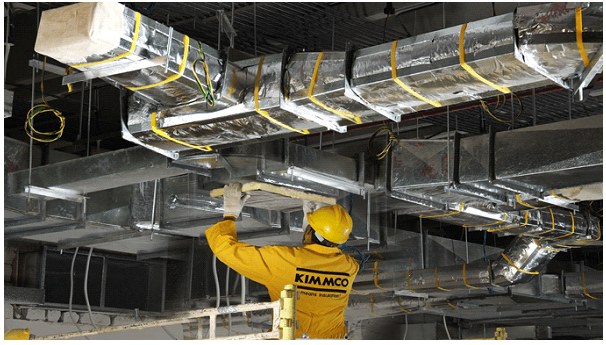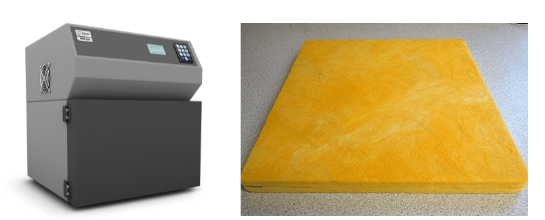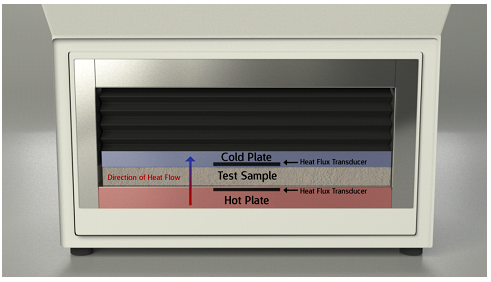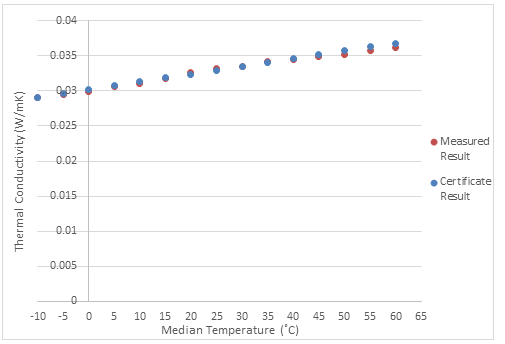Fibrous glass board (NIST SRM 1450d) is a durable, versatile and thermally efficient insulation board consisting of minute glass fragments, bonded to resins. These Fibrous glass boards may be installed on the exterior of sheet metal air ducts, as well as air-distribution boxes of HVAC systems. They also serve as a barrier, protecting the circulating air from dust, dirt and other pollutants. Fibrous glass boards come in various thicknesses, sizes and rigidities, depending on their area of use. These insulation boards not only provide a thermal barrier to varying external temperatures, they also provide acoustic insulation from noises caused by vibrations within the HVAC system.

Figure 1. Fibrous Glass Board being installed on the exterior of air ducts.1
Using the Thermtest Heat Flow Meter (HFM), researchers at Thermtest measured the bulk thermal conductivity (W/m·K) of the Standard Reference Material® (SRM) 1450d, Fibrous Glass Board from the National Institute of Standards & Technology (NIST), at various temperatures. The objective of this experiment was to confirm the reported accuracy and precision of the Thermtest HFM, within and outside of the certified temperature range of SRM 1450d. The reported precision of the Thermtest HFM is 0.5%, or better, and the reported accuracy of measurement is 3%, or better.
The National Institute of Standards and Technology (NIST) provides researchers with Standard Reference Materials (SRM) to achieve accurate and reproducible thermal conductivity data. SRMs are issued for materials with known and traceable thermal conductivities and thermal resistances. These SRMs are generally employed to assist in improving or verifying the accuracy and precision of thermal property instruments, like the Thermtest HFM.

Figure 2. The Thermtest Heat Flow Meter (HFM) pictured on the left and the Standard Reference Material® (SRM) 1450d, Fibrous Glass Board from the National Institute of Standards and Technology (NIST), on the left.
To begin, the 1450d specimen was placed between two parallel plates within the HFM. The specified temperature gradient across the plates (Ex: -5˚C to 15˚C) was then established, and the upper plate was set to compress onto the specimen, to the desired sample thickness (25.3 mm). At constant, but distinct temperatures, the parallel plates establish a steady state, one-dimensional heat flux through the specimen. Thermocouples embedded in each plate then measure the temperature on either side of the specimen and the heat flux transducers collect the resulting heat transfer data. By appropriate calibration with standards, and by measuring plate temperatures and plate separation, Fourier’s law of heat conduction was used to calculate thermal conductivity.

Figure 3. View from inside the HFM door. Parallel plates (red and blue) establish a one-dimensional heat flux through the test specimen, at desired temperature gradients.
According to NIST, the certified values of Thermal Conductivity (λ) for SRM 1450d are given by the relation, λ = 1.10489E-4⋅T, where is the mean sample temperature (K), valid from 280K to 340K or 6.85°C to 66.85°C.

Figure 4. Thermal Conductivity (W/mK) of the NIST SRM 1450d samples from 65˚C to -10˚C, calibrated against one layer of SRM 1450d from -10˚C to 65˚C. Note: The certificate temperature is from 280K to 340K, or 6.9˚C to 66.9˚C.
As can be seen in Figure 4, the thermal conductivity readings of the certified reference material from 65˚C to -10˚C showed an accurate representation of the certified values and were all well within the 3% accuracy window the Thermtest HFM demonstrates.
This experiment illustrates the importance of effective and accurate thermal conductivity measurements to advancing research of thermal conductivity instruments and materials. The Thermtest HFM is a simple, rapid, method for determining Thermal Conductivities (W/m·K) from a single, steady state measurement. As can be seen by the results, users can expect a high degree of accuracy (3%) and precision (0.5%), with this ASTM traceable measurement technique.
The Thermtest Heat Flow Meter (HFM) provides users with the ability to measure thermal properties of larger, flat slab specimens ranging in thermal conductivities from 0.005 to 0.5 W/m∙K. The Heat Flow Meter is capable of measuring the steady-state heat transfer properties of foams, solids, and textiles.
References:
ASTM C518-15, Standard Test Method for Steady-State Thermal Transmission Properties by Means of the Heat Flow Meter Apparatus, ASTM International, West Conshohocken, PA, 2015.
R. R. Zarr, A. C. Harris, J. F. Roller, J. F. and S. D. Leigh. (2011). Standard Reference Materials: SRM 1450d, Fibrous-Glass Board, for Thermal Conductivity from 280K to 340K. US Department of Commerce, National Institute of Standards and Technology, 128. Available at: http://www.nist.gov/srm/upload/SP260-173.pdf
Product Information from NAIMA: Fibrous Glass Insulation Boards. North American Insulation Manufacturers Association – Insulation Facts #67. Available at: http://insulationinstitute.org/wp-content/uploads/2015/11/AH140.pdf